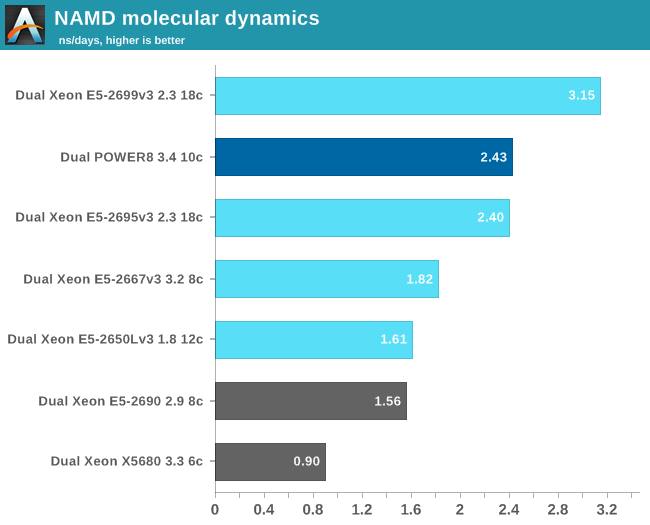The IBM POWER8 Review: Challenging the Intel Xeon
by Johan De Gelas on November 6, 2015 8:00 AM EST- Posted in
- IT Computing
- CPUs
- Enterprise
- Enterprise CPUs
- IBM
- POWER
- POWER8
Floating Point: NAMD
After quite a bit of trouble, we managed to port a real floating point application to our POWER8 system: NAMD.
Developed by the Theoretical and Computational Biophysics Group at the University of Illinois Urbana-Champaign, NAMD is a set of parallel molecular dynamics codes for extreme parallellization on thousands of cores. NAMD is also part of SPEC CPU2006 FP.
We used the "NAMD_2.10_Linux-x86_64-multicore" binary for our Xeons. Since there was no LE Linux version for POWER8, we built our own. We got it working with the g++ compiler and used these settings:
-O3 -mcpu=power8 -ftree-vectorize -mpopcntd
These setting should push GCC to generate as much VSX (Vector Scalar eXtenstion) code as possible. We used the most popular benchmark load, apoa1 (Apolipoprotein A1). The results are expressed in simulated nanoseconds per wall-clock day.

To put this in perspective: an early Xeon Phi (7120 1.2 GHz) scores about 4.4, A top NVIDIA GPU with CUDA based NAMD can score up to 20 and more. So it is clear that this kind of software will be run mostly on GPU accelerated servers.
But it is nonetheless a real world HPC benchmark. The IBM POWER8 is once again on par with the Xeon E5-2695v3. The NAMD binary does not seem to leverage AVX2, as the Xeon E5-2667 (16 cores) does not outperform the Xeon E5-2690 (AVX) with a large margin.










146 Comments
View All Comments
usernametaken76 - Thursday, November 12, 2015 - link
Technically this is not true. IBM had a working version of AIX running on PS/2 systems as late as the 1.3 release. Unfortunately support was withdrawn and future releases of AIX were not compiled for x86 compatible processors. One can still find a copy of this release if one knows where to look. It's completely useless to anyone but a museum or curious hobbyist, but it's out there.zenip - Friday, November 13, 2015 - link
...>--click here-Steven Perron - Monday, November 23, 2015 - link
Hello Johan,I was reading this article, and I found it interesting. Since I am a developer for the IBM XL compiler, the comparisons between GCC and XL were particularly interesting. I tried to reproduce the results you are seeing for the LZMA benchmark. My results were similar, but not exactly the same.
When I compared GCC 4.9.1 (I know a slightly different version that you) to XL 13.1.2 (I assume this is the version you used), I saw XL consistently ahead of GCC, even when I used -O3 for both compilers.
I'm still interested in trying to reproduce your results, so I can see what XL can do better, so I have a couple questions on areas that could be different.
1) What version of the XL compiler did you use? I assumed 13.1.2, but it is worth double checking.
2) Which version of the 7-zip software did you use? I picked up p7zip 15.09.
3) Also, I noticed when the Power 8 machine was running at full capacity (for me that was 192 threads on a 24 core machine), the results would fluctuate a bit. How many runs did you do for each configuration? Were the results stable?
4) Did you try XL at the less aggressive and more stable options like "-O3" or "-O3 -qhot"?
Thanks for you time.
Toyevo - Wednesday, November 25, 2015 - link
Other than the ridiculous price of CDIMMs the power efficiency just doesn't look healthy. For data centers leasing their hardware like Amazon AWS, Google AppEngine, Azure, Rackspace, etc, clients who pay for hardware yet fail to use their allocation significantly help the bottom line of those companies by reduced overheads. For others high usage is a mandatory part of the ROI equation during its period as an operating asset, thus power consumption is a real cost. Even with our small cluster of 12 nodes the power efficiency is a real consideration, let alone companies standardizing toward IBM and utilising 100s or 1000s of nodes that are arguably less efficient.Perhaps you could devise some sort of theoretical total cost of ownership breakdown for these articles. My biggest question after all of this is, which one gets the most work done with the lowest overheads. Don't get me wrong though, I commend you and AnandTech on the detail you already provide.
AstroGuardian - Tuesday, December 8, 2015 - link
It's good to have someone challenging Intel, since AMD crap their pants on regular basisdba - Monday, July 25, 2016 - link
Dear Johan:Can you extrapolate how much faster the Sparc S7 will be in your Cluster Benchmarking,
if the 2 on Die Infiniband ports are Activated, 5, 10, 20% ???
Thank You, dennis b.